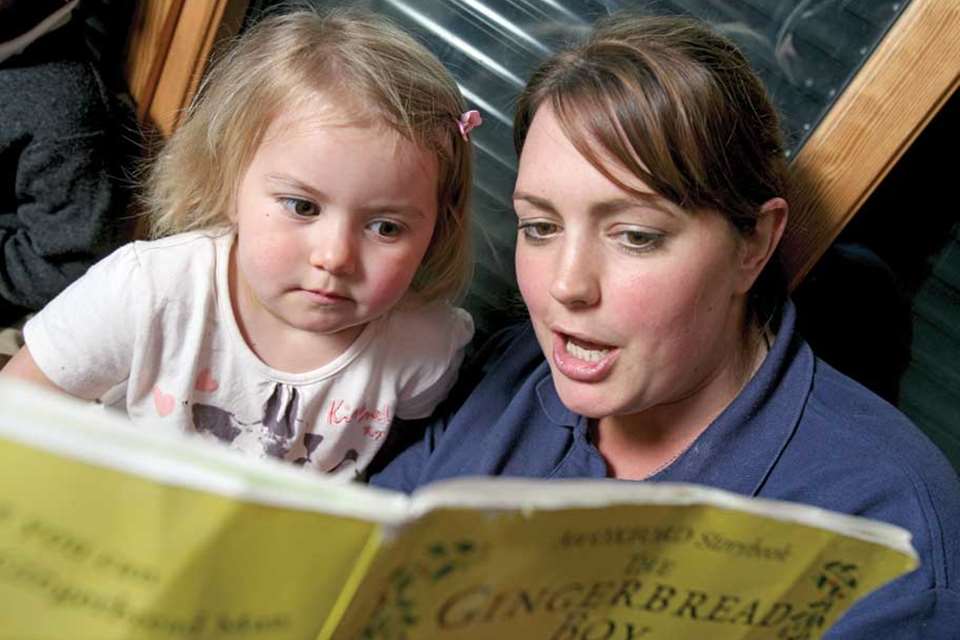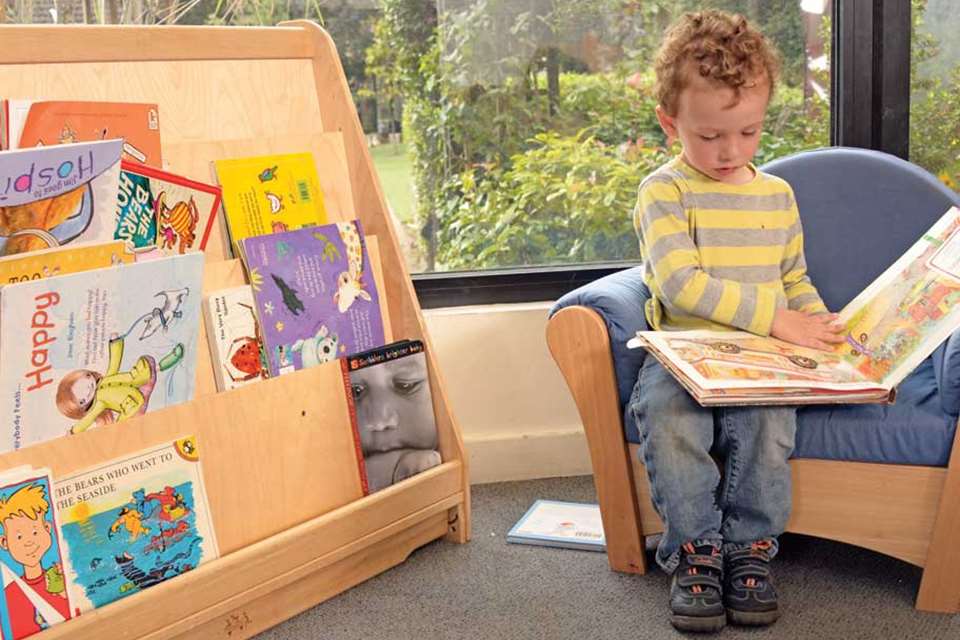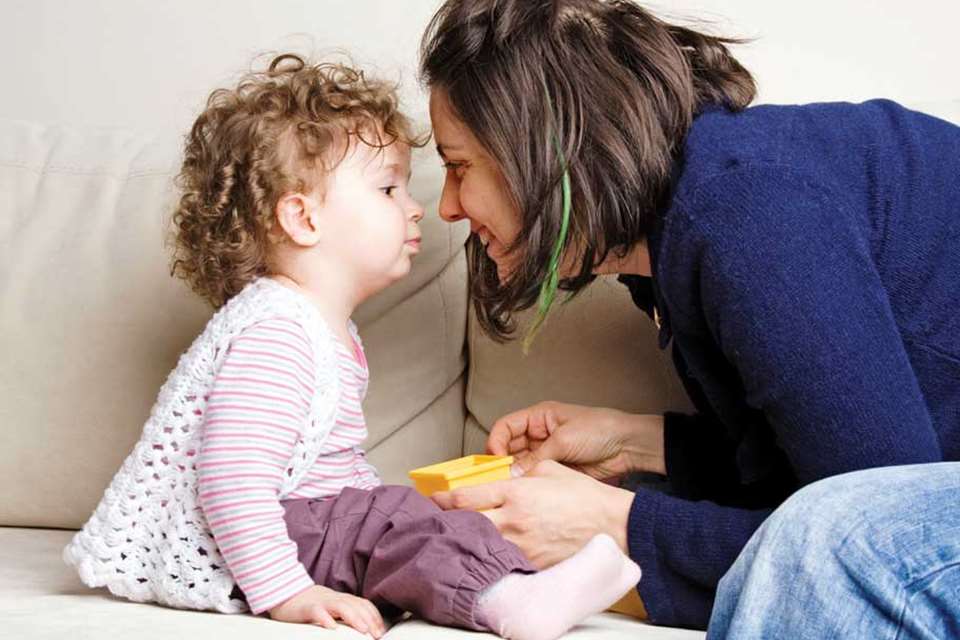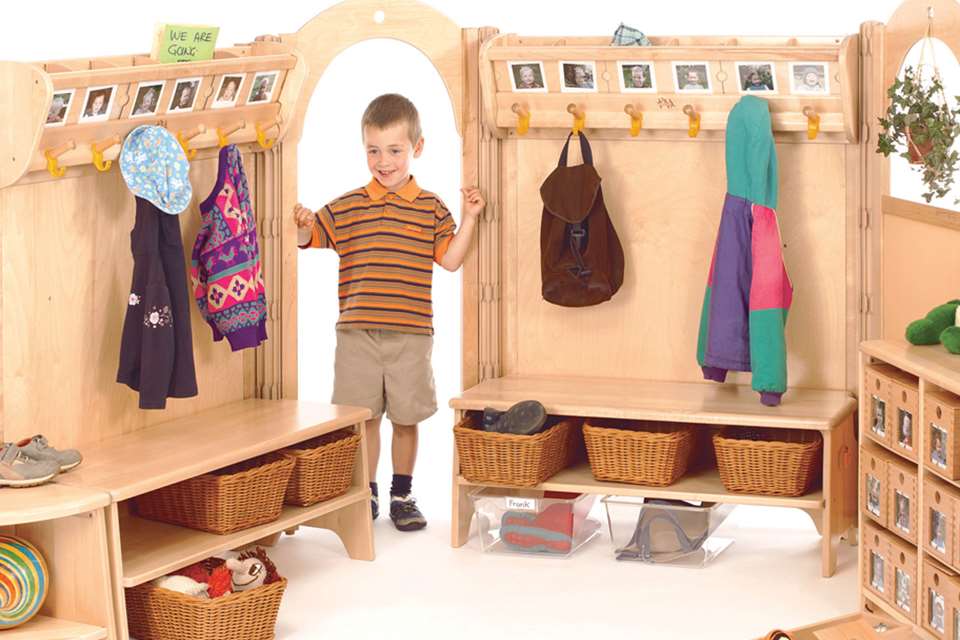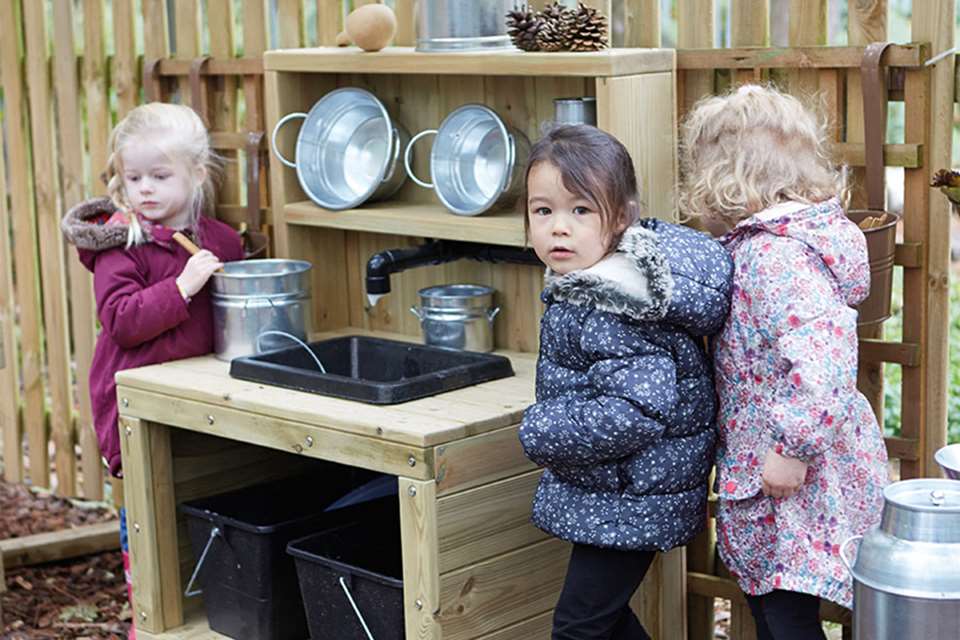Enabling Environments: Collections - Play it by ear
Nicole Weinstein
Monday, April 20, 2015
How can practitioners help children develop good listening skills? Nicole Weinstein offers some advice

Many young children have difficulties developing good listening skills. One in four children under the age of five has 'glue ear', which means that their hearing levels are affected each time they have a cold. Building up good listening skills is vital for recognising sounds, developing speech, following instructions, learning rhymes and songs and communicating with others - and sets the foundations for future literacy and numeracy skills.
It is important, therefore, that practitioners model good communication skills by listening to the child's thoughts and feelings and tuning into their interests. Other activities that support the development of children's early listening skills include stories, rhymes and listening games.
AUDITORY DISCRIMINATION
In recent years, there has been an increased emphasis on listening and attention, and in particular on young children identifying individual phonemes.
Judith Stevens, an early years consultant specialising in maths and early language, explains, 'This focus began with children in Reception, but increasingly practitioners working with nursery-aged children of three or even younger are planning activities to support the identification, and more worryingly, replication of these tiny units of sound.
'Unfortunately, this rather misses the point that for many very young children identifying the difference between the noises made by a car, a person, a doorbell and a dog still produces a huge challenge.'
For those children whose auditory discrimination is limited, particularly for those who come from homes where the television is constantly on, or those with glue ear, they are unlikely to be able to even hear the tiny units of sound like 's', 'b', 't' and 'n', not to mention pronounce them.
It is, therefore, essential that all early years practitioners are aware of the early learning goal for 'listening and attention' as part of the prime area of Communication and Language, and are clear that this is for the end of the Reception year, not for two, threeor even young four-year-olds.
The aim under the listening and attention goal is that: 'Children listen attentively in a range of situations. They listen to stories, accurately anticipating key events and respond to what they hear with relevant comments, questions or actions. They give their attention to what others say and respond appropriately, while engaged in another activity.'
The non-statutory guidance for the Early Years Foundation Stage offers many suggestions on how to support the development of early listening, and the Every Child a Talker materials are still well used in many local authorities and available on www.foundationyears.org.uk.
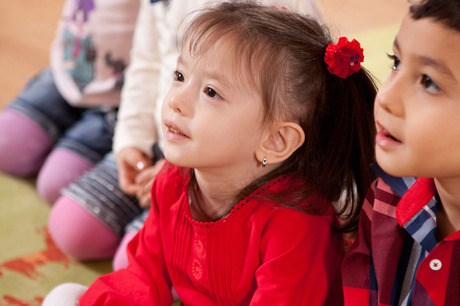
TUNING IN
Stories, rhymes and exciting listening games will help children to develop listening skills. Dialogic book talk is another useful tool to use with young children.
Rather than a group of children listening to a book being read by an adult, dialogic reading involves small groups of children and adults having a conversation about the book. They can talk about the text and the pictures, spend time on a favourite page or make connections with their own lives. The adult becomes an interested listener, a questioner and an audience for the child and this means the child becomes the teller of the story.
This method is particularly useful, according to Judith Stevens, who says, 'In many settings, there is no cohesive approach to supporting the development of children's listening and attention. Practitioners need to model listening to children, being very clear that communication is a two-way process - "Ok, I am listening to you now; it's your turn to talk".
'Practitioners also need to tune in to children's interests, passions and enthusiasms. Young children are much more likely to listen if someone is talking about something that actually interests them, in a meaningful and relevant situation, at an appropriate time - ie, not when they are totally engaged in a very physical, active, game with friends outdoors.'
ACTIVITIES AND RESOURCES
Here are some examples of useful activities and resources that promote early listening skills.
Sound discrimination games
Play games that support children to listen carefully and discriminate sounds from each other. Try those that involve matching instruments, copying rhythms and beats, listening for sounds in the environment, identifying animal sounds, sound lotto and music games such as musical bumps.
Best buys
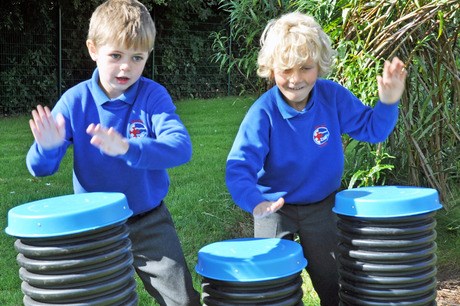
 For copying rhythms and beats, try Guiro Pipe Drums (£82.50), Bish, Bosh, Bang and Clang Set (£27.99), Boomwhackersboomophone Whack Pack (£31.49), Large Set - Little Hands Basket (£59.95), Musical Bells - Large (£18.79) Junk Music Walls Trio, (£149.95), Massive Junk Music Kit (£99.95), Broom Claves (£3.79), Open-Ended Sound Boxes (£16.99), Steady Beat Drums (£6) and Music Set for Phase 1 Phonics (£23), all from Cosy Direct on 01332 370152.
For copying rhythms and beats, try Guiro Pipe Drums (£82.50), Bish, Bosh, Bang and Clang Set (£27.99), Boomwhackersboomophone Whack Pack (£31.49), Large Set - Little Hands Basket (£59.95), Musical Bells - Large (£18.79) Junk Music Walls Trio, (£149.95), Massive Junk Music Kit (£99.95), Broom Claves (£3.79), Open-Ended Sound Boxes (£16.99), Steady Beat Drums (£6) and Music Set for Phase 1 Phonics (£23), all from Cosy Direct on 01332 370152.
Talking Tubes Who's Speaking, Who's Listening (£49.99), www.reflectionsonlearning.co.uk.
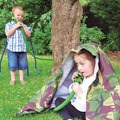 Forest Phones (£19.99) from www.reflectionsonlearning.co.uk
Forest Phones (£19.99) from www.reflectionsonlearning.co.uk
Music Resource Collection (£200) at http://shop.earlyexcellence.com
Percussion Tubes: Diatonic (£17.50) at www.wesco-eshop.co.uk
Go on listening walks. Take buckets, bags and baskets and collect leaves, stones and pebbles along the journey. Try the Shopping Basket Oval (£9.99), the Plastic Bucket (£1.50), the Small Natural Cotton Tote Bag (£1.09), and make a sound basket after reading The Sounds Around Town by Maria Carluccio (£8.99). All resources from www.thechildmindingshop.co.uk
Stories and rhymes
Develop children's ability to pay attention to and engage in active listening through story and rhyme times. Bringing story time outside helps to engage boys in listening activities. Create story circles using logs, mushroom seats, cushions and crates. Providing children with opportunities for children to join in and retell familiar stories encourages children to focus on the language and structure of the stories they hear.
Best buys
Outdoors try the Outdoor Library Station (£105), Book Spine Self Stand Fences (£99.95), Bonanza Cushion Pack and Store - 30 pack (£99.95), the H Crate Class Pack - 30 pack (£230) with the Camo crate cushions (£24.99), the Burnished Author's Chair (£129.99), the Chat-a-Ring - 30 seats) (£160), Mini Mushrooms Half Class Set - 15 pack (£140), the 2m Grass Circle (£45.99), the 3 Bears Rustic Porridge Set (£24.99) and Billy Goats Gruff Bridge (£169), all Cosy Direct.
Nursery Rhyme Singing Sack (£44.95) or matching the rhyming pairs in Rhyming Pieces (£33.95), both from www.tts-group.co.uk
A range of storysacks from www.hope-education.co.uk includes The Gruffalo Storysack (£149.95), the Old McDonald Puppet, Book and CD Set (£33.95), Nursery Rhyme Book and CD Pack (£17.75) and Noisy Farm Pack (£39.95).
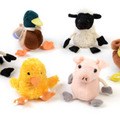 Puppets and props are an excellent way to develop listening skills by enhancing a story or using different voices. Try the Puppet Resource Collection (£225), the Gingerbread Men - Puppet Set (£9.95) or the Farm Animal Finger Puppets (£23.95), from http://shop.earlyexcellence.com/collections.
Puppets and props are an excellent way to develop listening skills by enhancing a story or using different voices. Try the Puppet Resource Collection (£225), the Gingerbread Men - Puppet Set (£9.95) or the Farm Animal Finger Puppets (£23.95), from http://shop.earlyexcellence.com/collections.
Kamishibai Picture Theatre (£131.70), from www.wesco-eshop.co.uk.
To encourage children to listen to stories and rhymes at home, there are a variety of 'going home' bags to share with parents at www.earlyexcellence.co.uk. Try the Going Home Bags Collection 2 (£225), which includes ten bags with songs and rhymes, storybooks and soft toys, as well as popular characters and vehicles. Other collections of books, including the Traditional Tales Book Collection (£29.95) and the Roadside Emergencies Book Collection (£24.95) are also at www.earlyexcellence.co.uk.
We're Riding on a Caravan storysack (£60) and We're Sailing to Galapagos storysack (£50) both have catchy, repetitive and melodic refrains. Unusual collections of wooden or metal items, like the Metal and Wooden Top Up Sets, (£43 each), are perfect for experimenting with sounds. All available from www.playtoz.co.uk
ICT
There is an ever-growing variety of ICT resources that can help support listening skills in young children.
Best buys
The Tune Into range of listening CDs from www.yellow-door.net encourages children to listen to sounds in the environment, animal sounds and instrumental sounds (from £14 each).
Come Alive Listening Complete Set (£150) from www.yellow-door.net, includes an interactive CD, games and activities pack.
ICT resources from www.tts-group.co.uk include Easi-Ears - Digital Audio System (£399.95), which enables teachers to put their own audio content onto the wireless headphones so that children can listen independently or as a group, Talk Time Postcards (£11.99), Talking Photo Album A5, A4 and A3 versions (from £24.95) and Big Point (£44.95), six large buttons that can record up to 30 seconds of sound or speech. Or for outdoors, try Talking Daisies (£99.95), Talking Tree (£99.95) or Recordable Rocks (£99.95) and the Talking Clipboards A5 and A4 versions (from £9.99).
Talking Tins (£5.40) from www.ypo.co.uk help children to develop their speaking and listening skills. Record and playback speech, music or sound effects.
StoryPhones Headsets, www.storyphones.co.uk, are individual MP3 players with a rechargeable batteries for listening to stories and songs, indoors and outside (from £82.50 for a Personal MP3 Headset with 2GB memory).
Micro-Speak (£39.95) from www.hope-education.co.uk captures voice memos and sound effects while on the move.
Listening Kit (£39.60) lets groups of children listen to stories on tape/CD/MP3 together, and Sound Boxes (£25.60) gets children to identify two identical sounds. Both are available from www.wesco-eshop.co.uk
PLAYING WITH SOUNDS
Practitioners can read about development of listening and attention and the links to literacy in Getting Ready for Phonics - L is for Sheep, edited by Sally Featherstone (new edition 2013).
As Judith Stevens and Kym Scott note (page 134): 'Children need to have experience of playing with sounds in each of the different stages of phonological awareness, so that they are learning to distinguish between smaller and smaller units of sound. These stages are:
- - developing auditory awareness (general sound and speech sounds discrimination)
- - developing awareness and rhythm and beat (syllabic awareness)
- - developing rhyming skills (awareness of onset and rime [phonological units of a spoken syllable])
- - developing phonemic awareness (awareness of alliteration and individual phonemes).'
Overemphasis on individual phonemes too early will generally be unsuccessful, cause stress and often switch children off.
However, the use of appropriate listening experiences, such as those described using Lola the Listening Leopard in Helping Young Children to Listen by Ros Bayley and Lynn Broadbent and Helping Very Young Children to Listen: 40 games and activities to encourage listening and concentration skills by Andrina Flinder by practitioners who listen themselves will make a difference.
CASE STUDY: ALFRETON NURSERY SCHOOL
A two-way dialogue including adults and children is encouraged at all times at Alfreton Nursery School in Derbyshire. Nursery teacher Jane Blant explains, 'Respectful behaviour supports the development of each child's confidence and competence when speaking and listening. Children know that they have the right to be listened to when they are speaking and that they then have the responsibility to listen to others.'
To help teach them this, there are three story groups involving the use of a puppet. Daisy Duck is used to promote basic social skills and her story time rules include, 'good looking, good listening and good sitting or lying on your tummy'.
Following on from this is Maisy Mouse, where the expectations are increased and the selected stories are more detailed. Rainbow Fish is the most advanced story group where the children follow their routine or algorithm on the iPad. Each day, there is a different focus, including rhyme and alliteration, rights and responsibilities and ecosystems.
Ms Blant says, 'First and foremost, we aim to motivate and engage children to want to be involved, to encourage them to want to listen and to develop their attention skills. For example, our weekly plan is based on a storybook and so to hook the children into the story we have an imagination basket containing a vibrant selection of resources to support the story. These include items such as puppets, dressing-up costumes and objects relating to the story that will ignite the children's interest. The basket is introduced to the children at story time where the practitioner will read the story using the resources to encourage and arouse the children's interest and attention. The basket is then accessible for the children to use throughout the week. This has proved to be a really powerful approach to promoting children's listening and attention.
'The Ferre Laevers monitoring tool is a major part of our practice, where we observe and record levels of engagement and well-being. This enables us to plan specific activities and interventions to meet individual children's needs and interests. Celebrating children's voices is also paramount. We have a variety of specific rewards including Clever Badges, Respectful Rachel Stickers, Baking Betty Stickers and Good Listening Stickers for Daisy Duck.'
Other activities that practitioners use to develop early listening skills at Alfreton Nursery School include:
- - Yoga Bugs - during this session, which helps develop core muscle strength, children listen carefully to instructions and have the opportunity to lie quietly and relax while hearing a story.
- - Talking Time with Charlie Chatterbox, a caterpillar puppet - children take a turn on the talking chair and tell Charlie whatever they would like to talk about. The rest of the children are encouraged to listen until it is their turn. Chatterboxes are also used as a home-school link. In addition to this, Charlie is used for social singing sessions and small group speaking and listening activities (for example, hiding an instrument and identifying sounds or passing the shopping bag and recalling the contents).
- - Baking with Betty - an adult-led baking activity where children follow simple instructions while developing communication skills.
- - Roly Poly Friday - during this small social group aimed at developing core muscle strength, Charlie Chatterbox meets and greets the children individually and nurtures their confidence and ability to listen and respond.
MORE INFORMATION
'All about... dialogic reading', www.nurseryworld.co.uk/nursery-world/feature/1142944/eyfs-practice-about-dialogic-reading
Audio discrimination - for a parent's guide and advice to practitioners, see www.nurseryworld.co.uk/nursery-world/feature/1143812/home-learning-activities-listening and www.nurseryworld.co.uk/nursery-world/feature/1143811/home-learning-practitioners-listen.


